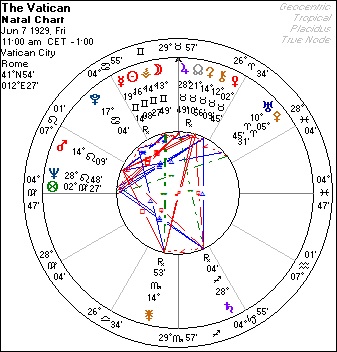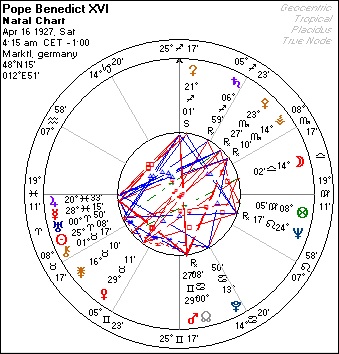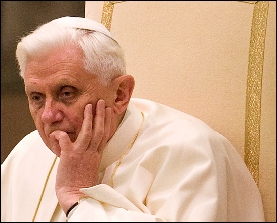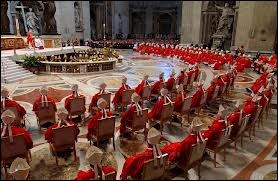advertisements
NeptuneCafe presents
The Astrology of Papal Conclaves and Pope Benedict XVI
On February 11, 2013, Pope Benedict said in a historic announcement he no longer had the mental and physical strength to run the Roman Catholic Church and would become the first pontiff in more than 700 years to resign. This transition was anticpated in an article written by NeptuneCafe's resident astrologer two years ago. Here's the story.
Pope Benedict XVI
Uranus in the Vatican horoscope is found in the 8th house of sex and death. In sexual matters, Uranus here (in Aries) can be interpreted as an aggressive interest in unusual sexual encounters or those that go beyond consensus norms. This can mean homosexuality, pedophilia, rape, indecent exposure, and so on. Alternatively, Uranus here can also be seen as the need to liberate oneself from sexual desire, which apparently is how most priests use this archetype. Becoming independent of human flesh or carnal desires is seen as a virtue in that it allows one to focus more on the spiritual side of life.
The Papal Conclaves
The death of a pope (or in this case, the resignation) is generally anticipated as he ages, but when the event actually happens, it's still felt as a sudden turn of events. The people grieve, and then anticipation and excitement build as the media speculates on who will be the next pope. The entire process is very Uranian – the unexpected or sudden change of course, the excitement in the air, and nowadays, the buzzing in the airways via the electronic media.
The material on this page is an excerpt from an article by Michael O'Reilly originally published in Dell Horoscope's October 2011 issue.
There's much more: see The Vatican
Pope Benedict XVI (April 16, 1927; 4:15 am; Marktl, Germany) has a horoscope that looks every bit like it belongs to a pope. Jupiter conjunct the Pisces Ascendant is the essence of a religious personality, especially one that enjoys the rituals, pomp, and pageantry. When he was five years old, the Cardinal Archbishop of Munich visited his village, and he was immediately struck by the colorful costumes. He announced to his family that day that he would become a cardinal. Since Jupiter rules his tenth house of career, his chart was set up from the beginning to follow this path.
Jupiter is part of a Water Grand trine involving Pluto in Cancer and Vesta in Scorpio. The asteroid Vesta is often associated with the devoted life, and her focus turns religious with the connections to Jupiter and Pluto. The water signs suggest an intense inner passion for meditation and prayer, and a protective, self reliance that gains confidence through faith in a higher order and divine justice.
His Aries Sun participates in a Fire Grand Trine, which includes Neptune in Leo and the Sagittarius Midheaven. This helped him to rise quickly within the Catholic hierarchy. Saturn in the ninth house of religion likewise reflects his ambition to lead a religious life, especially as an authority figure.
Like many popes before him, Benedict has a prominent Ceres. It's located in Sagittarius near his Midheaven, so that he evokes a caring, nurturing attitude toward the people he presides over. Similarly, Pope Pius XII, Pope John XXIII, and Pope Paul VI all had Ceres Rising. John Paul II had Ceres conjunct Venus, the ruler of his chart.
For readers who would like to further explore the popes' horoscopes, from astrodatabank, here's the rest of the birth data for the popes active since the signing of the Lateran Treaty: Pope Pius XI (May 31, 1857; 8:00 am; Desio, Italy), Pope Pius XII (March 2, 1876; 10:30 pm; Rome), Pope John XXIII (November 25, 1881; 9:25 am; Sotto Il Monte, Italy), Pope Paul VI (September 26, 1897; 10:30 pm; Consescio, Italy), and the ill-fated Pope John Paul I (Oct 17, 1912; 11:30 am; Canole D'Angordo, Italy).
Although a prominent Ceres is found in most of these charts, it's not universal. The only common planetary signature I found in all these charts is a Pallas-Neptune aspect. Pallas, the asteroid known for its political astuteness, wisdom and creative intelligence, helps mediate the spiritual or transcendent presence associated with being pope.
Pius XI had Pallas quincunx (150º) Neptune. Pius XII had Pallas near his Scorpio Ascendant opposite Neptune, while his successor John XXIII had Pallas conjunct his Sagittarius Ascendant and trioctile Neptune (trioctile is the 135º aspect, also known as the sesquiquadrate). Pope Paul VI had Pallas octile (45º or semi-square) Neptune, and Pope John Paul I had Pallas sextile Neptune.
With the exception of John Paul I, who lived a scant 33 days as pope, all these Pallas-Neptune aspects can be considered "challenging". These popes all had their controversies as they tried to express their self-designated "infallibility" in the real world. Pope John Paul II was blessed with Pallas in assertive Aries trine Neptune and Jupiter in his tenth house. He was the only one who seemed to gracefully glide through the world, easily blending his pioneering political insights with religious protocol.
Pope Benedict XVI has Pallas in Scorpio square Neptune. With Pallas in the eighth house of sex, this signature assured that he would have to deal with the worst sexual abuse cases that had been accumulating over the decades. Pandora's box was opened during his predecessors' watch, but he had to manage the fallout.
As it turns out, Benedict had been managing the predator priest problem since November 25, 1981, when Pope John Paul II appointed him to head up the "Sacred Congregation for the Doctrine of the Faith", a centuries' old Catholic institution formerly known as the Inquisition. Officially, this top level post has authority over the teaching of church doctrine, but one of its subsidiary roles is jurisdiction over clerical sexual misconduct. Known as Cardinal Ratzinger at this time, he held this position until he was elected pope in 2005.
Astrologers can see the importance of this assignment as a career move through the many transits and progressions to his natal horoscope. Transiting Neptune had arrived at his Midheaven, bringing him a long-term position in his religious vocation. Transiting Pluto opposite his Sun suggested the deep personal transformation this would have on his life, as well as some of the complex sexual matters he would have to resolve. By secondary progression, the love planets Venus and Mars were conjunct at 1º Leo where they squared his natal Chiron. Here we have the signature of dealing with wounded sexual relationships, which readily translates into dealing with predator priests.
In 2006, a BBC documentary called Sex Crimes and the Vatican noted that in 1962 the Sacred Congregation for the Doctrine of Faith had promulgated a new policy aimed at absolute secrecy and control of all sexual abuse cases by the Catholic clergy. Under this internal mandate, all allegations of sex abuse were to be handled within the church diocese rather than civil authorities. Extraordinary cases were sent to the Vatican, and from November 1981 on, Cardinal Ratzinger handled the problem from there. The BBC documentary referred to this 1962 doctrine as "a secret church decree called Crimen Sollicitationis". It "imposes the strictest oath of secrecy on the child victim, the priest dealing with the allegation, and any witnesses. Breaking that oath means instant banishment from the Catholic Church – excommunication."
While Pope John Paul II is the larger, more mythic figure, Pope Benedict is the one who is bringing real change with regard to predator priests. Most appropriately, he took office when the Vatican's progressed Sun was conjunct natal Neptune. And in accordance with misty Neptune's square from the 12th house to flamboyant Jupiter at the Midheaven, all is not as it seems within the Vatican.
There's more on Pope Benedict. See Vatican, part 2
With regard to the Papal Conclave, Uranus by transit often brings unexpected events or crises. Located in the 8th house of transformation, Uranus transits can symbolize the passing of one pope and the election of his successor. And in fact, when reviewing the celestial conditions when the last six popes have died (since the Lateran Treaty was signed in 1929), transiting Uranus has always been a key factor.
The first Pope to die in the modern era was Pope Pius XI, the one who negotiated the Lateran Treaty with the Kingdom of Italy. His death on February 10, 1939 took place as transiting Uranus was conjunct the Vatican's Ceres and only 0º10' from squaring the 12th house Mars. As Uranus made the exact hit to Mars, the Papal Conclave was meeting. By March 2, the cardinals announced that they had arrived at a decision in the traditional manner – by sending a puff of white smoke from the iron stove up through its narrow metal chimney to the outside world.
Pope Pius XII died on October 9, 1958 as transiting Uranus was conjunct the Vatican's 12th house Mars. A few weeks later, Pope John XXIII was chosen, but he lived only five years after he was elected. But Pope John XXIII was keen on modernizing some of the Catholic rituals and doctrines, and so called for a grand meeting to discuss how these changes should be implemented. The so-called Second Ecumenical Council of the Vatican (the first one was a hundred years earlier and was interrupted by war) opened on October 11, 1962, but didn't finish its business until December 8, 1965.
Pope John XXIII didn't live to see the completion of this controversial attempt at modernization. He died on June 3, 1963 when progressed Mars was conjunct the Vatican Ascendant at 4º Virgo. At the same time a transiting Mars-Uranus conjunction was also on the Vatican Ascendant, so that these basic celestial ingredients had all piled up on the Virgo Ascendant.
The next pope took the name of Paul VI. He carried on the business of reforming the Church, and attempted to mediate traditional beliefs and messages with the revolutionary social, political and technological changes of the time, as seen astrologically by that era's Uranus-Pluto conjunction. Pope Paul VI died on August 6, 1978 when transiting Uranus in Scorpio was squaring the Vatican Mars. Also at the time, transiting Neptune and Pluto were closely aspecting natal Mars, while the transiting Sun at 14º Leo activated all these outer planet hits.
1978 was a weird year as far as papal history goes. It's sometimes referred to as the "Year of Three Popes", because the next elected pope, Pope John Paul I, lasted only 33 days in office. He died on September 28, 1978 when transiting Mars was only 0º05' from squaring the 12th house Mars. He was followed by the popular Pope John Paul II. It might be difficult to state why three popes held office in 1978, but a strong Pluto influence is a good starting place. The progressed Midheaven was conjunct natal Pluto at the same time transiting Pluto was conjunct the progressed Ascendant. Pluto leads to all kinds of complications, and here we have a doubled Pluto theme involving both the Vatican's angles.
Up to this point, transiting Uranus has made hard aspects to the Vatican's 12th house Mars in three distinct periods, and each one corresponded to the death of a pope. The exception was Pope John XXIII who died when transiting Uranus was conjunct the Vatican Ascendant. The next major Uranus transit to natal Mars would be in 1999 when transiting Uranus opposed Mars.
Pope John Paul II was one of the most influential leaders in the 20th century and served longer than any other pope except Pius IX. In 1999, many viewed John Paul II's health condition with deep concern. His stooped posture, the slow painful speech, and the trembling hands suggesting Parkinson's Disease all seemed to say he was nearing death. Yet he endured right through the 1999 turning point, and finally passed away on April 2, 2005 when transiting Uranus was opposite the Vatican Ascendant.
The orb of this Uranus transit is a bit wide - 4º away. But other transits and progressions pinpoint this date as the transition time. Most significantly, the progressed Sun was exactly squaring Jupiter at the Midheaven, signifying the culmination of a great reign. Also, the progressed Midheaven was conjunct natal Mars, which verifies and underscores the relevance and importance of this placement.
The next quadrature aspect (conjunction, square, or opposition) between transiting Uranus and natal Mars doesn't occur until 2022. Will Pope Benedict XVI live that long? Undoubtedly, the Vatican's Uranus Return in 2013 will bring a major transition of some kind, especially since transiting Neptune will be conjunct the Vatican Descendant at the same time. Neptune has also played a role in marking the papal passages, especially during the Year of Three Popes when it opposed the Sun. Neptune's alignment with the Vatican Sun brought confusion, conspiracy theories, and scandal. Something similar might be anticipated in 2013.
Comments, questions? email wolfstar
Asteroid Reports
Officially titled Asteroid Goddesses in the Natal Chart, this 45-page comprehensive report is written by asteroid experts Demetra George and Douglas Bloch. In these pages, the four primary asteroids are fully explained, both in their general signficances as a feminine archetypes, and the meaning of each in your natal chart. Cost is $25. Email wolfstar to order your report or to discuss how it can be bundled with a personal reading.
What kind of transitions can you expect? For personal consulations, email wolfstar@neptunecafe.com





